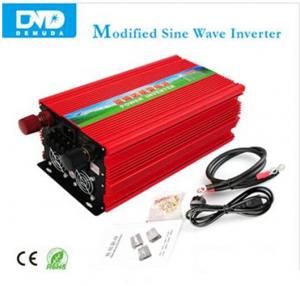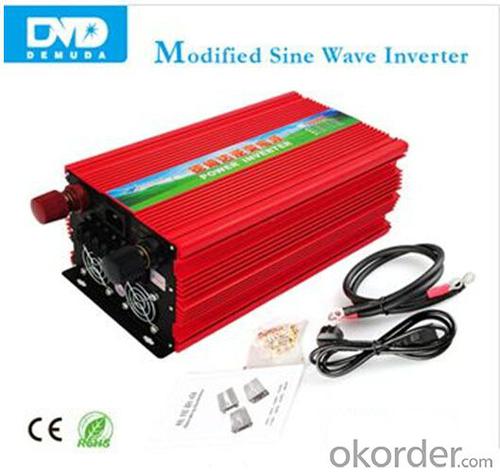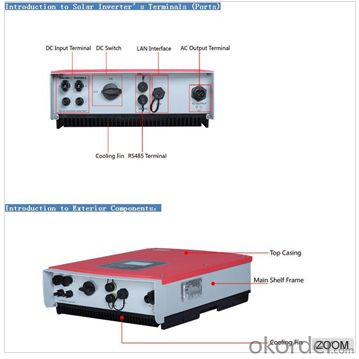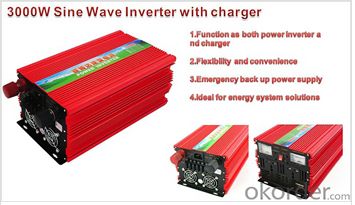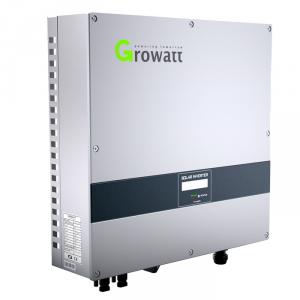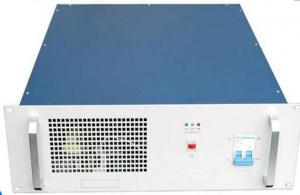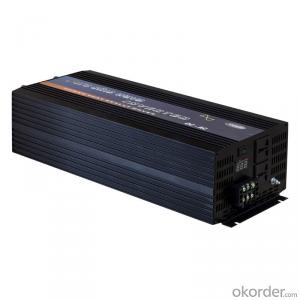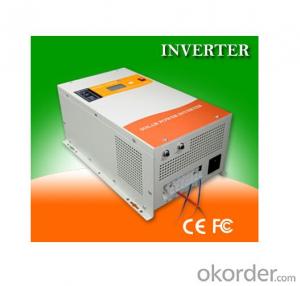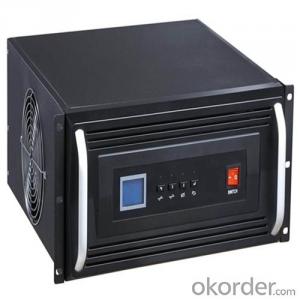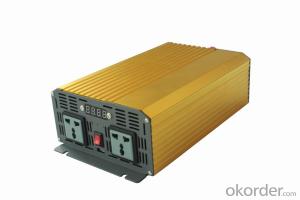3ph Solar Inverter Modified Sine Wave 3000W
- Loading Port:
- China main port
- Payment Terms:
- TT or LC
- Min Order Qty:
- 50 unit
- Supply Capability:
- 1000 unit/month
OKorder Service Pledge
OKorder Financial Service
You Might Also Like
1. Structure of Solar Inverter, High quality Single Phase Modified Sine Wave 3000w Description
The inverter series is an electronic product that has been designed and built to take low DC woltage power from batteries and convert it to
standard AC power like the current you have at home.
The Inverter series is a DC-to-AC with auto line-to-battery transfer and intergrated charging system. Inverter series powers from ACpower
and DC source, serving as an extended run UPS. When AC cable is connected to a wall socket, utility power goes to connected equipment
and/or charges the battery set via charging system. In Inverter mode, the Inverter series automatically converts battery energy into AC power
for backing up the connected devices.
2. Main Features of Solar Inverter, High quality Single Phase Modified Sine Wave 3000w
• Low voltage protection
• Over voltage protection
• Overload protection
• Over temperature protection
• Short circuit protection
3. Solar Inverter, High quality Single Phase Modified Sine Wave 3000w Images
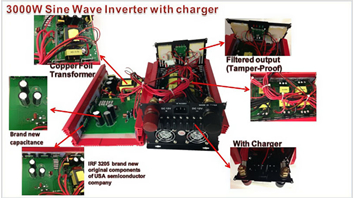
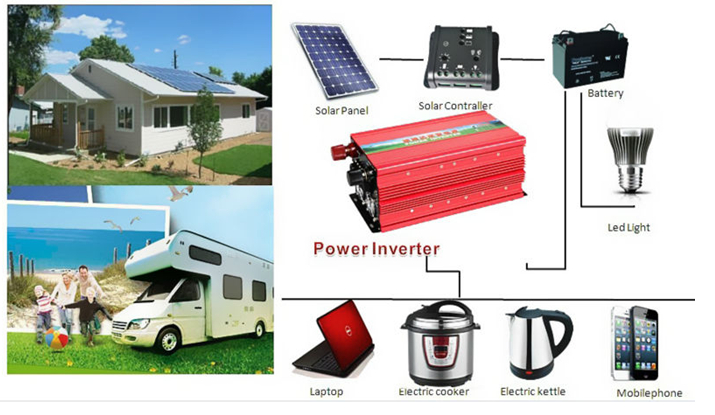

4. Solar Inverter, High quality Single Phase Modified Sine Wave 3000w Specification
Model No. | DMD-3000W/24V/F/CA | |
Input Section | DC Input Voltage | 24V |
DC Operating Voltage | 21-29V | |
DC Low-voltage Protection | 18.5-20.5V | |
DC Low-voltage Alarm | 19.5-21V | |
DC Over-voltage Protection | ≥29V | |
Fuse | 20A*2 | |
Quiescent Current | ≤0.5A | |
Output Section | Output Waveform | Modified Sine Wave |
Output Voltage | 220V±10% | |
Output Frequency | 50Hz±1% | |
Power Rating | 3000W | |
Continue Output Rating | 3000W | |
Peak Power Rating Output | 6000W | |
Transfer Efficiency | ≥90 % | |
Overload Protection | 3000W--3600W | |
Short-circuit Protection | Yes | |
Operating Temperature | -10°C--+50°C | |
Temperature Protection | +60°C--+70°C | |
Green LED Indicator | Green Light(Working),Flash(Overload Protection) | |
Red LED Indicator | Red Light(Error Protection) | |
Size | Size: 305 x 165 x 125mm | |
Weight | 5.5kg | |
Packing | Color box packing or skin packing | |
5. FAQ of Solar Inverter, High quality Single Phase Modified Sine Wave 3000w
Q1:Can we visit your factory?
A1:Sure,welcome at any time,seeing is believing.
Q2:Which payment terms can you accept?
A2:T/T,L/C,Moneygram,Paypal are available for us.
- Q: Can a solar inverter be integrated with energy management systems?
- Yes, a solar inverter can be integrated with energy management systems. By connecting a solar inverter to an energy management system, it allows for better monitoring, control, and optimization of the solar power generated. This integration enables efficient management of energy consumption, storage, and distribution, leading to increased energy efficiency and cost savings.
- Q: Are there any electromagnetic interference concerns associated with solar inverters?
- Yes, there are electromagnetic interference (EMI) concerns associated with solar inverters. Solar inverters convert the direct current (DC) generated by solar panels into alternating current (AC) that can be used to power homes and businesses. During this conversion process, high frequency switching occurs, which can generate EMI. EMI refers to the disturbance caused by electromagnetic radiation from electronic devices, which can interfere with the proper functioning of other electronic devices in close proximity. In the case of solar inverters, the EMI generated can potentially affect nearby electronic equipment, such as radios, televisions, or communication systems. To mitigate these concerns, solar inverter manufacturers often comply with relevant EMI standards and regulations. These may include limits on the amount of electromagnetic radiation emitted by the inverters and the use of shielding materials to reduce EMI. Additionally, some inverters incorporate filters or other EMI suppression techniques to minimize the interference created. It is important for solar installers and system designers to consider EMI concerns when selecting and positioning solar inverters. Proper installation and grounding techniques can help reduce EMI issues. Additionally, local regulations and guidelines should be followed to ensure compliance with EMI standards and to minimize potential interference with other electronic devices. Overall, while there are EMI concerns associated with solar inverters, proper design, installation, and adherence to relevant standards can effectively mitigate these concerns and ensure the smooth operation of both the solar system and other electronic equipment in the vicinity.
- Q: Can a solar inverter be used in systems with different module efficiencies?
- Yes, a solar inverter can be used in systems with different module efficiencies. Solar inverters are designed to convert the DC power generated by solar panels into AC power, regardless of the module efficiency. The inverter's main function is to optimize the power conversion process and ensure compatibility between the solar panels and the electrical grid. As a result, it can accommodate varying module efficiencies and still function efficiently.
- Q: What is the difference between a centralized and decentralized solar inverter system?
- A centralized solar inverter system has a single inverter that is responsible for converting the DC power generated by multiple solar panels into AC power for use in the building or to be fed back into the grid. In contrast, a decentralized solar inverter system has individual inverters connected to each solar panel, allowing for independent conversion of DC power into AC power. The main difference lies in the level of control and flexibility, as centralized systems typically offer more efficient power conversion but are reliant on the performance of the entire system, while decentralized systems provide greater adaptability and fault tolerance but may have slightly lower efficiency.
- Q: Can a solar inverter be used with solar-powered outdoor lighting?
- Yes, a solar inverter can be used with solar-powered outdoor lighting. A solar inverter converts the direct current (DC) generated by the solar panels into alternating current (AC) that is required to power the outdoor lighting fixtures. This allows for efficient and reliable operation of the solar-powered lighting system.
- Q: What is the role of a solar inverter in a net metering system?
- The role of a solar inverter in a net metering system is to convert the direct current (DC) produced by the solar panels into alternating current (AC) that can be used to power appliances in a home or business. It also ensures that any excess electricity generated by the solar panels is fed back into the grid, allowing the user to earn credits or be compensated for the excess energy.
- Q: How does a solar inverter handle sudden changes in solar irradiation?
- A solar inverter handles sudden changes in solar irradiation by continuously monitoring the incoming solar energy and adjusting its output accordingly. When there is a sudden increase in solar irradiation, the inverter quickly ramps up its power conversion to match the higher energy input. Similarly, when there is a sudden decrease in solar irradiation, the inverter reduces its power conversion to align with the lower energy input. This dynamic response ensures that the inverter efficiently converts the available solar energy into usable electricity, maintaining a stable power output despite fluctuations in solar irradiation.
- Q: Can a solar inverter be used with different AC voltages?
- No, a solar inverter cannot be used with different AC voltages. It is designed to convert the DC power generated by solar panels into a specific AC voltage that is compatible with the electrical grid. Using it with a different AC voltage could lead to inefficient operation or even damage the inverter.
- Q: What is the role of a voltage regulation feature in a solar inverter?
- The role of a voltage regulation feature in a solar inverter is to ensure that the voltage output from the solar panels is maintained at a stable and optimal level. This helps to protect the sensitive electrical components in the solar inverter and other connected devices, while also maximizing the efficiency and performance of the solar power system.
- Q: What safety features should a solar inverter have?
- A solar inverter should have several safety features, including overvoltage protection, overcurrent protection, ground fault protection, and arc fault protection. Additionally, it should have robust insulation to prevent electrical shock hazards and be equipped with sensors to monitor temperature and prevent overheating. Finally, it should have a secure enclosure to protect against environmental factors such as water, dust, and debris.
Send your message to us
3ph Solar Inverter Modified Sine Wave 3000W
- Loading Port:
- China main port
- Payment Terms:
- TT or LC
- Min Order Qty:
- 50 unit
- Supply Capability:
- 1000 unit/month
OKorder Service Pledge
OKorder Financial Service
Similar products
Hot products
Hot Searches
Related keywords
